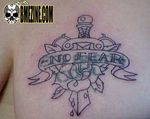Tattoo Cover-Up: Difference between revisions
(Created page with "<html><div class="mw-content-ltr" dir="ltr" id="mw-content-text" lang="en"><p>Faced with a tattoo you don't want, you have two main options (other than "deal with it") for the problem. <a class="mw-redirect" href="/index.php?title=Tattoo_removal" title="Tattoo removal">Tattoo removal</a> is of course one option, but it's extremely expensive, painful, and often leaves a scar, so many people choose to do a cover up. </p><p>A cover up may take the form of <b>reworking</b> w...") |
(Page conversion via llm-mediawiki-rev -jwm) |
||
| Line 1: | Line 1: | ||
Faced with a tattoo you don't want, you have two main options (other than "deal with it") for the problem. [[Tattoo removal]] is of course one option, but it's extremely expensive, painful, and often leaves a scar, so many people choose to do a cover up. | |||
A cover up may take the form of '''reworking''' which is basically going over the same tattoo in an attempt to clean it up — making the outlines crisper and bolder, refreshing the colours, and so on. If the original tattoo artwork is acceptable but poorly applied, this is usually the best option. | |||
In the case of a true (and total) cover up, the artist uses a larger and darker design to "cover" the existing tattoo. '''GREAT''' care should be exercised in choosing an artist to do the coverup, as you don't want to make it '''WORSE'''! | |||
In the past, cover ups were often rather crude. [[Black Panther]], [[Tribal|tribal tattoo]] designs and 8-balls were your best option. These days, inventive tattooists who utilize a balanced sense of light and shading can cover most tattoos so nicely that the man on the street would never have known anything else was ever there. | |||
[[White Ink]] is sometimes used to lighten the old tattoo in preparation for cover up, and others will partially remove a tattoo before covering it up (since tattoo removal often takes several sessions, slowly lightening the piece). | |||
<center> | <center> | ||
{| class="wikitable" | |||
|- | |||
|[[File:Cover_Up-1.jpg|thumb|right|150px|Cover Up]] | |||
|[[File:Cover_Up-2.jpg|thumb|right|150px|Cover Up]] | |||
|[[File:Cover_Up-3.jpg|thumb|right|150px|Cover Up]] | |||
|- | |||
|} | |||
==See Also== | |||
* [[Tattoo Touch-Up]] | |||
* [[Tattoo Blow-Out]] | |||
Latest revision as of 18:47, 25 September 2023
Faced with a tattoo you don't want, you have two main options (other than "deal with it") for the problem. Tattoo removal is of course one option, but it's extremely expensive, painful, and often leaves a scar, so many people choose to do a cover up.
A cover up may take the form of reworking which is basically going over the same tattoo in an attempt to clean it up — making the outlines crisper and bolder, refreshing the colours, and so on. If the original tattoo artwork is acceptable but poorly applied, this is usually the best option.
In the case of a true (and total) cover up, the artist uses a larger and darker design to "cover" the existing tattoo. GREAT care should be exercised in choosing an artist to do the coverup, as you don't want to make it WORSE!
In the past, cover ups were often rather crude. Black Panther, tribal tattoo designs and 8-balls were your best option. These days, inventive tattooists who utilize a balanced sense of light and shading can cover most tattoos so nicely that the man on the street would never have known anything else was ever there.
White Ink is sometimes used to lighten the old tattoo in preparation for cover up, and others will partially remove a tattoo before covering it up (since tattoo removal often takes several sessions, slowly lightening the piece).


